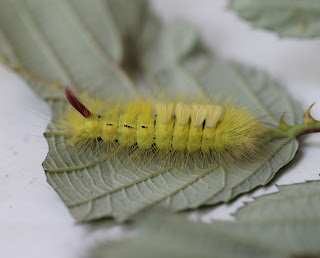 |
| Pale Tussock Moth (Calliteara pudibunda) (larva) |
Now here is a fistful of spikes. This brightly coloured caterpillar was found in a cocoon of silken threads inside a rolled bramble (or blackberry) leaf. Often this tactic leads on to pupation, but in this instance it was just a case of growing out of one skin and needing a newer, larger one. 'Instar' is the word to describe this transition. The title of the post is the name of the caterpillar in Kent where it used to be found in the hop fields.
 |
| Burnished Brass (Diachrysia chrysitis) |
A patch of brightness in amongst the browns and duns gathered in the trap. The Burnished Brass is startling and unmistakable and can be found in two varietes where the one (juncta) is distinguished from the other (aurea) by the broad, central brown marking being either complete or broken into two patches. The one in the photograph is complete so it is aurea.
 |
| Red-green Carpet (Chloroclysta siterata) |
The Red-green Carpet (Chloroclysta siterata) rests with the end of its abdomen curled upwards - rather like the Phoenix moth. The name covers quite a broad range of varieties of colouring but the tail is a good indicator. When lured by the mercury vapour light it often fails to enter the trap and can be found, like this one, on the outside of the plastic covering. It flies away quickly if disturbed like most of the carpets moths.
Pale Tussock caterpillar unrolled
Here is the caterpillar unrolled and resting on the undersided of a blackberry leaf. The thorns can be seen on the right of the photograph and are very sharp but do not deter the undulating insect larva. The separate segments of the body are like an accordion and the underlying colour, beneath the yellow and white, is one of the deepest blacks I have ever seen. It will continue to munch until November, grow in size and then overwinter as a pupa.

